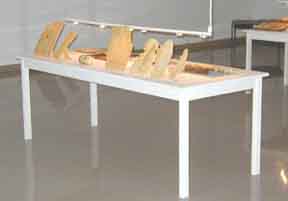ABOVE: Aganetha Dyck's installation at Gallery One One One,
2000. Photograph by Peter Dyck.
Edited by Serena Keshavjee.
AGANETHA DYCK: Nature as Language
Acknowledgments
I would like to thank the staff at Gallery One One One for their support of this exhibition, held in November of 2000, and of this catalogue. My appreciation goes out to Cliff Eyland, Donalda Johnson, and Robert Epp. Dale Amundson must also be mentioned for getting behind the project from the beginning. My greatest thanks go to the artist, Aganetha Dyck, who not only produces beautiful and delicate objects, but with whom it is also a great pleasure to work at all times, and under all conditions. In addition, when one works with Aganetha, one also gains an entire family support system. Dyck's son, the artist Richard Dyck, created a superb sound installation of the
working bees for the exhibition, and her husband Peter Dyck helped with all aspects of the installation, the documentation of the show and the crating. William Eakins' photographs of the bees in Aganetha's hives graced the invitations and the posters. The invitations and the posters were elegantly designed by Sam Khouvongsavanh, who also gave us technical and design help whenever we needed it. Cliff Eyland designed and laid out the CD-ROM.
I would also like to express my gratitude to the authors and contributors to this catalogue. I heard Mark L. Winston, Professor of Biological Sciences at Simon Fraser University, on C.B.C. radio a few years ago and immediately recognized that his attitude towards bees was similar to Aganetha's. They seemed a perfect match. Dr. Winston has written a lyrical introduction about these enigmatic creatures for this catalogue. Juan Antonio Ramírez, Professor of Art History at the University of Madrid and author of The Beehive Metaphor :From Gaudi to Le Corbusier, has contributed an essay which intriguingly compares Aganetha's glass and honeycomb wedding dress (National Gallery of Canada, Ottawa) with Marcel Duchamp's Large Glass (Philadelphia Museum of Art). He finishes his essay by describing Aganetha's work as a living skin of wax and honeycomb that delicately covers the banal objects she places into the hive. My essay reinforces the themes that Winston and Ramírez both hint at, that Aganetha's work is in the Neo Romantic tradition, and that she is grappling with the issues regarding humanity's relationship with nature. Dyck uses the braille version of the alphabet and the honeycomb surface produced by the bees in a similar way as a text that we struggle to decipher, but always fail to do so. The thorough bibliography accompanying this catalogue was researched by Rebecca Stillwell, an art history student at the University of Winnipeg, and I thank her for agreeing to contribute to this endeavor. Oliver Botar acted as an unofficial editor for the catalogue and we are all grateful for his critical eye.
- Serena Keshavjee, University of Winnipeg
The Aganetha Dyck: Nature as Language CD-ROM includes essays, images and the interactive work called The Wax Museum which is an Aganetha Dyck, Richard Dyck and William Eakin collaboration. The disk also contains information about other Gallery One One One exhibitions: $20.00 plus shipping = $25.00 payable to Gallery One One One, School of Art, Main Floor, FitzGerald Building, University of Manitoba Fort Garry campus, Winnipeg, MB, CANADA R3T 2N2
TEL:204 474-9322 FAX:474-7605
For information please contact Robert Epp
eppr@ms.umanitoba.ca

